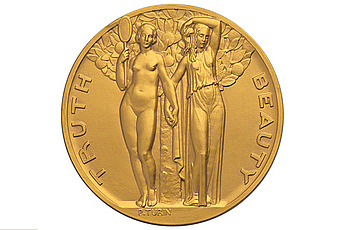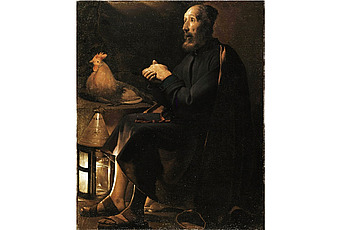Irving Lavin (1927–2019), Iconic Art Historian, Dies at 91
Press Contact

Irving Lavin, Professor Emeritus in the School of Historical Studies at the Institute for Advanced Study, passed away in Princeton on February 3 at the age of 91.
Lavin was an art historian distinguished by his charismatic and challenging teaching, rigorous search for the relationship between form and meaning in the visual arts, and the conviction that the study of the history of art was the study of the history of ideas. He was renowned for his tenacious explorations of difficult subjects, and his willingness to see all the facets and possibilities of their solutions.
“Irving exemplified the characteristics of a world leading scholar and humanist in his generosity, enthusiasm, and curiosity, which spanned diverse disciplines,” said Robbert Dijkgraaf, Director and Leon Levy Professor. “The Institute community, where Irving made his intellectual home for 45 years, was enriched by his presence, his insights, and his dear friendship. He will be greatly missed here and around the world.”
Lavin’s deep knowledge of Italian art and culture was the result of over fifty years of study, particularly in Rome, where he embraced the city and encouraged Italian art history to move into the world of intellectual creativity. For this gift, the city offered him many honors, including the Tercentennial Medal, commemorating the death of Gianlorenzo Bernini (1980), and the Premio Daria Borghese (1981), and appointed him Honorary Member of the Corporation of Sculptors and Marble Workers of Rome as well as Membro Straniero della Accademia Nazionale dei Lincei. He also received the Premio Internazionale “Galileo Galilei,” from the University of Pisa (2005), the Sescentennial Medal, commemorating the birth of Donatello, from L’Accademia delle Arti del Disegno, Florence (1986) and was made Accademico d’Onore by Accademia Clementina, Bologna (1986). He died as he was about to fulfill his last invitation: to be plenary speaker at the Fondazione Caetani colloquium on sixteenth-century Roman sculpture (March 2019). His last article on “The Silence of David by Gianlorenzo Bernini” will be published posthumously in the periodical Artibus et Historiae, in the Spring 2019 issue.
“Irving Lavin continued to be part of the life of the School of Historical Studies until a few weeks before his passing. The breadth of his knowledge on the history of art and culture was phenomenal, as was his ability to recognize connections between seemingly disparate phenomena,” said Angelos Chaniotis, Professor of Ancient History and Executive Officer of the School of Historical Studies. “With an alert mind and youthful curiosity, he took a genuine interest in the projects of the Members, created bridges between the disciplines, and stimulated discussions.”
Lavin began his career studying philosophy at Washington University in St. Louis, Missouri, and at the invitation of Bertrand Russell went to Cambridge University to become his tutee. He soon became aware that such a theoretical field was not for him and took up more practical studies, namely the history of art. Within ten years he had degrees from New York University and Harvard University, and had won the prestigious Arthur Kingsley Porter Prize for Scholars under 40 three times (’59, ’62, and ’68)—so often, in fact, the paradigm for the prize was changed. In 1966, Lavin began a series of discoveries, the first of which brought to light the earliest marble portrait bust made by the young prodigy Gianlorenzo Bernini at the age of 14 years. That discovery was only the first of many previously unknown Bernini busts made throughout his career. Lavin’s last contribution was a black-and-white marble sculpture of the famous Roman lawyer Prospero Farinacci (d. 1619), published in the spring of 2018.
Lavin was born on December 14, 1927, in St. Louis, Missouri. He received his B.A. from Washington University (1948), his M.A. from the Institute of Fine Arts, New York University (1951), and an M.A. (1952) and Ph.D. (1955) from Harvard University for his dissertation, “The Bozzetti of Gianlorenzo Bernini.” He taught on the faculties of Washington Square College, New York University (1957–59; 1963–66); Vassar College (1959–61); the Institute of Fine Arts, New York University (1967–73); and Princeton University (1974–90). Lavin joined the Institute’s School of Historical Studies as a Professor in 1973 and became a Professor Emeritus in 2001.
Reflecting on Lavin’s appointment and early years as a Professor in the School, the late Carl Kaysen, IAS Director 1966–76, observed in an Oral History interview, “I found it interesting that Irving could talk about nineteenth-century English art as well as about Bernini and as well about Tunisian mosaics. [...] Irving fulfilled the notion of real intellectual interaction across the faculty boundary.” With John Elliott, Professor in the School from 1973–90, Lavin worked to make the School more cohesive in the 1970s, with a focus on actively encouraging the appointments of younger Members. As Elliott recalled in an Oral History interview, Lavin viewed the Institute as an international center with an international message and as “a place of refuge for younger people to get on with their own work as visiting Members.”
Lavin’s publications show his wide-ranging intellectual interests: from late antique architecture (Triclinia) to North African, particularly Tunisian, floor mosaics, the Renaissance (Donatello, Michelangelo, Pontormo, and Giovanni Bologna), the Baroque (Caravaggio and Bernini), to the twentieth century, with essays on Picasso and Jackson Pollock. He also communicated easily with practicing artists and was close friends with George Segal, Mel Bochner, Frank Stella, and traveled with and wrote about Frank O. Gehry.
His books include Bernini and the Crossing of St. Peter’s (1968); Bernini and the Unity of the Visual Arts (1980); Past–Present: Essays on Historicism in Art from Donatello to Picasso (1993); Santa Maria del Fiore: Il Duomo di Firenze e la Vergine Incinta (1999); and Caravaggio e La Tour: La Luce Occulta di Dio (2000). The first two volumes of a projected six-volume edition of his collected works have been published as Visible Spirit: The Art of Gianlorenzo Bernini (2007–09), while the third volume has appeared as Bernini at St. Peter’s: The Pilgrimage (2012). A gathering of his essays on modern and contemporary art, The Art of Art History, has also appeared in Italian as L’Arte della storia dell’arte (2008).
Lavin was a celebrated lecturer: he gave the Franklin Jasper Walls Lecture at the Pierpont Morgan Library in New York (1975); the Slade Lectures at Oxford University in 1985; the Thomas Spencer Jerome Lectures at the University of Michigan and the American Academy in Rome, 1985–86; the Una’s Lectures in the Humanities, University of California, Berkeley, 1987; and the Andrew W. Mellon Lectures in the Fine Arts, National Gallery of Art, Washington, D.C., in 2004. In 1993, Lavin hosted a centennial symposium on the work of Erwin Panofsky at the Institute for Advanced Study, where Panofsky had been a Professor.
In addition to his scholarly production, he gave considerable efforts to shaping the directions of art historical research in North America. He was a founding member of the committees charged with the creation of three new institutes dedicated to research in the history of art and architecture in America and abroad: The J. Paul Getty Research Center (Los Angeles); The Center for Advanced Study in the Visual Arts (CASVA), the National Gallery, Washington, D.C.; and the Canadian Centre for Architecture (CCA), in Montreal, Canada.
In 2011, he and his wife, Professor Marilyn Aronberg Lavin, co-authored a small book titled Truth and Beauty at the Institute for Advanced Study, in which they explore the origin and historical framework of the Institute and its seal, designed in 1931 by French artist Pierre Turin. Lavin writes in the introduction, “It is our joint hope that, to some extent, this perhaps excessively academic study expresses the gratitude we both feel for the precious gifts we have received over the years from this wondrous place.”
Lavin is survived by his wife of 66 years, Marilyn Aronberg Lavin, a distinguished art historian, their daughters, Amelia Lavin and Sylvia Lavin, her husband Greg Lynn; and grandchildren, Sophia Lavin Lynn and Jasper Lavin Lynn.


